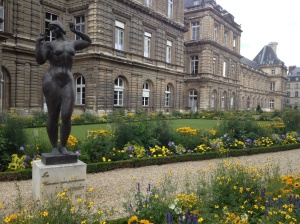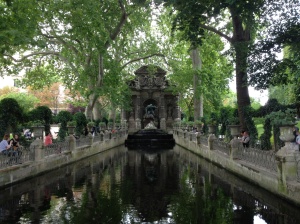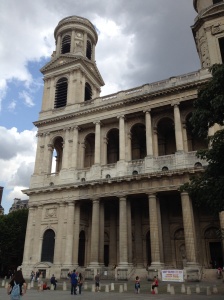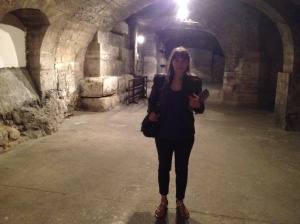The Senate and the Chamber of Deputies buildings…would require a visit. There were rumors that the former had suffered seriously and that there had been a fire in the library of the latter which had caused untold damage. These buildings were not under the protection of the Administration of Fine Arts, but were supervised by their own individual staffs. On the way out to the Luxembourg Palace, which houses the Senate, I asked my French driver where all the bronze statues were which had dotted the city’s streets. “Melted down by the Boche,” he replied. At the entrance to the Senate grounds Carpeaux’s memorable bronze figures, Four Quarters of the World supporting a globe, were not in their fountain basin. It was beginning to appear that none of these historic bronze monuments for which Paris was renowned had escaped German melting pots.
Later I obtained a list of the monuments which were taken by the Germans to make instruments of war. It was a relief to find that the Carpeaux figures were not on the list. These along with some of the other better sculptures had been hidden by the French in stone quarries and in the strongly vaulted subterranean passageways of churches such as St. Sulpice (J. Rorimer, 57-58).
Having read my grandfather’s description, naturally, I was curious about the “subterranean passageways.” It was time to investigate St. Sulpice. My friend navigated, and we found our way to a bench on the plaza just outside the church. Prior to entering, she asked me what I hoped to accomplish during this visit. Feeling buoyed up from our morning meeting with Madame L. (see my post entitled “You took my sister, I’m taking your apartment”), I stated my mission with confidence, “I want to go inside and see what the church looks like and if possible have a look underground.” We climbed up the steps and entered the church of St. Sulpice.
St. Sulpice, 2014
It turns out St. Sulpice is famous for three murals painted by Delacroix, but I was so focused on my mission that I forgot to take note of the art. Instead, we searched for someone to talk to. My friend, whose French is better than mine, spotted a valuable clue on a bulletin board – an announcement for tours of the crypt. The dates did not align. It was Monday and the next tour was not until Sunday. But tours of the crypt did exist!
In the vestry, we found an old lady seated behind a small, wooden desk. She invited us to sit down and I explained that I was retracing my grandfather’s path during World War II. She listened intently, touching her hand to her heart. When I finished, she made copies of my picture post-card, my grandfather’s book, and “The Monuments Men” book business card. Then, she turned to the priest and showed him the passage in the book that mentioned St. Sulpice. After examining the page, he agreed to let us see the crypt. My friend and I exchanged gleeful glances. The lady motioned for us to gather our things, as she negotiated with a caretaker standing nearby. It sounded as if she said, “Oh, just show them around a little bit.” The caretaker looked as if he would prefer not to be bothered, but he jangled his keys and led us downstairs to the basement anyway. I couldn’t believe we were getting a special tour, but there was no time to celebrate. I got out my camera and followed the man.
The underground vaults were expansive. Here and there, I saw a few sculptures and remnants of colonnades, but mostly the crypt was empty. The man unlocked two gates and led us further underground, into the dark. We followed closely behind. I was just about to use the flashlight app on my iPhone, when he flipped on a light switch. All I could say was “très intéressant.” Casually, he lit a match and began smoking a cigarette. Then he pointed to a water faucet. He turned it on, and after a short delay, we heard the sound of water falling hitting the ground many feet below. The caverns were deep!
The Crypt
I imagined the spaces filled with the grand public statues from the Senate building. At what point did the Parisians decide to move art into the crypt? How did they transport it? How full were the caverns? There were so many questions I wished I could ask, but instead I had to use my imagination. I snapped a few photos and we returned upstairs to the vestry. We thanked the reluctant caretaker, the priest and the old lady profusely, then bade them farewell practicing the few French words we definitely knew, “Merci Madame! Au revoir Monsieur!”
Once again, I was amazed by the way this mission had connected me with people in such unexpected and meaningful ways. Their willingness to listen and subsequent outpouring of kindness was incredible. Our mutual understanding crossed through time, space and language barriers.
N.B. No. 1: Nowadays, Carpeaux’s Four Quarters of the World can be found in the Musée D’Orsay in Paris. I didn’t get a chance to see them this time, so I’ll have to return another time.
N.B. No. 2: The Metropolitan Museum of Art in New York City just held an exhibition dedicated to Carpeaux a few months ago. I made a point of going because I had just read this passage in “Survival,” and I wanted to know who Carpeaux was!
http://www.metmuseum.org/exhibitions/listings/2014/carpeaux








I am enjoying your blog posts so very much. I imagine your grandfather would be so pleased to know you are retracing his steps so carefully. The personal crypt tour sounds exciting. It makes me think of “The Cask of Amontillado.” I learned of your blog through your Socal friend.
Cecil, thank you so much for reading! I really feel like I’m having a dialogue with my grandfather as I read and re-read his narrative. It’s amazing to connect with someone I never actually met, but I feel that I’m getting to know him well through this whole process. 🙂
St. Suplice. Oh my gosh, I realize that I lived just so near by for a summer and never went into
it. And now I see what I missed! So thank you Sarah, for these grand bits of history come alive and I wonder if you have a book in the making – it does seem to me a good idea! I am so glad to be on your list of the privileged who get to travel with you vicariously. Carry on, dear, and know we are all right with you! Nan
Wow! Small world! So glad you are able to come with me vicariously! Thank you so much for reading!
Sarah, I, too, feel blessed to be on your privileged list of correspondents. It would be very exciting to be using my high school German along with you.
Richard A. Engel
Thanks Dr. Engel! As it turns out, I’ve been using less German in Germany than French in France. Everyone one I’ve met speaks English VERY well!